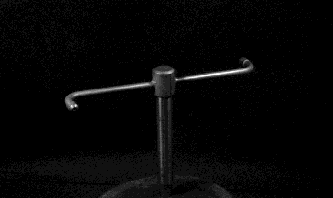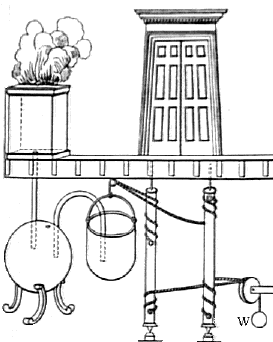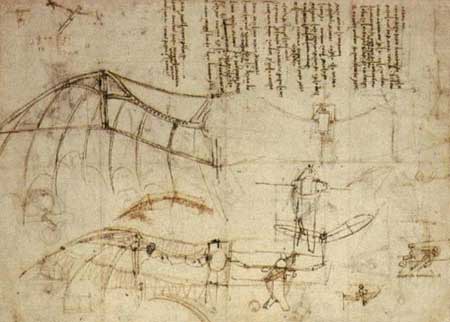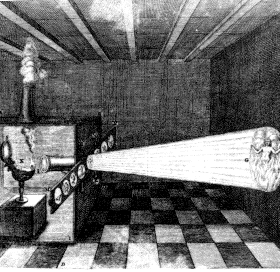
Il primo congegno azionato dalla forza del vapore í¨ la “sfera di Eolo” o Eolipila (vedere l’animazione) inventato da Erone, ingegnere greco del I secolo d.C. L’eolipila í¨ una turbina a reazione capace di erogare una piccolissima potenza, non sfruttabile in pratica.
Essa rappresenta il primo tentativo di impiegare il vapore per ottenere energia meccanica.
Erone í¨ famoso anche per altri meravigliosi congegni, uno dei quali serviva per aprire (e chiudere) automaticamente le porte di un tempio, vedi figura a lato. Utilizzava l’espansione dell’aria calda per mettere in pressione l’acqua di un serbatoio che, attraverso un sifone, andava a riempire un secchio sospeso. La discesa del secchio faceva aprire le porte del tempio.
Se il fuoco viene spento, la pressione nel recipiente diminuisce e l’acqua ritorna indietro, svuotando il secchio.
Allora il peso W (in basso a sinistra) cadendo fa chiudere le porte.
www.museoscienza.org

“Maquinas vi incríveis: O espelho ustator, a eolipila de Athanasius Kircher. A luz de círios e candeias um cone capta a incidir num círculo de vidro com desenhos í maneira de zodíaco, o feixe de luz desenrolando a imagem por sobre uma parede branca: Padre Athanasius aciona a roda para dar vida ao movimento, almas agitam braços frenéticos entre as chamas do inferno ou os eleitos giram em torno do Pai, – lanterna mágica a coar sombras na caverna platônica”.
Catatau pg 18/19 – primeira edição
A lanterna mágica de Athanasius Kircher (1602 – 1680),
experimento precursor do cinema moderno.
Kircher é considerado o pai da geologia científica
e da egiptologia. Em sua imensa produção,
mais de 39 livros, é frequentemente
comparado a Leonardo da Vinci pela
precisão matemática e pluralidade de seu gênio
“Kircher’s treatise on light, Ars magna lucis et umbrae (Rome, 1646), treats also of the planetary system. In it he shows no inclination to follow the heliocentric system, but he does favor Tycho Brahe’s model in which the planets circle the sun. Some other inventions are found in this book, such as the magic lantern, the predecessor to the movies”
O sistema de amplificação sonora de Kircher – Megaphone –

“Leonardo, aquele engenho tão agudo quanto artífice sutilíssimo não compôs um autômato semovente í maneira de humano? Dia virá em que se ponham altares a um deus-máquina”.
Catatau pg 19 – primeira edição

“Among these are drawings that experts today believe were designs for robotsââ?¬â?which, if true, would make Leonardo the worldââ?¬â?¢s first roboticist.
The sketches in question were made around 1495, but were unknown until an Italian scholar named Carlo Pedretti found them in the 1950s. Nothing in the several pages of drawings looks like a complete robot; the gears, pulleys, cables, and so on appear to untrained eyes to be random machine components. But Pedretti believed that taken together, they could represent the plan for a mechanical man. Leonardo apparently intended a suit of armor to be used as the robotââ?¬â?¢s body. Several decades after the sketchesââ?¬â?¢ discovery, a robotics expert named Mark Rosheim came across Pedrettiââ?¬â?¢s description of Leonardoââ?¬â?¢s robot. Rosheim studied the drawings extensively and, using computer simulations, determined exactly how they could have fit together to form a humanoid robot. The digital model of the robot showed that it could sit up, wave its arms, bend its legs, move its head, and open and close its jaw; a mechanical apparatus in the chest controlled arm movements, while an external crank moved the legs. Leonardoââ?¬â?¢s humanoid robot was clearly based on his long and detailed study of human anatomyââ?¬â?the same research that had led to his famous Vitruvian Man drawing and its accompanying list of proportions in about 1490. But apparently, this was not Leonardoââ?¬â?¢s first foray into the world of robotics. An earlier drawing, from 1478, was thought for years to be the design for a spring-powered cart. But Rosheimââ?¬â?¢s analysis showed that it was much more than that. The mechanism inside could be adjusted (by replacing various cams) to determine the course the cart would travel. In other words, it was, in a manner of speaking, a programmable analog computerââ?¬â?and since it was also mobile, it could be considered a robot.”

Me parece mais uma mÃ?¡quina de extermÃ?Ânio nazista, mas Ã?© sÃ?³ apenas uma abstraÃ?§Ã?£o que a imagem amputada em movimento sugere. AliÃ?¡s, a coisas surgem do nada, e o instrumento Ã?© apenas um testemunho.